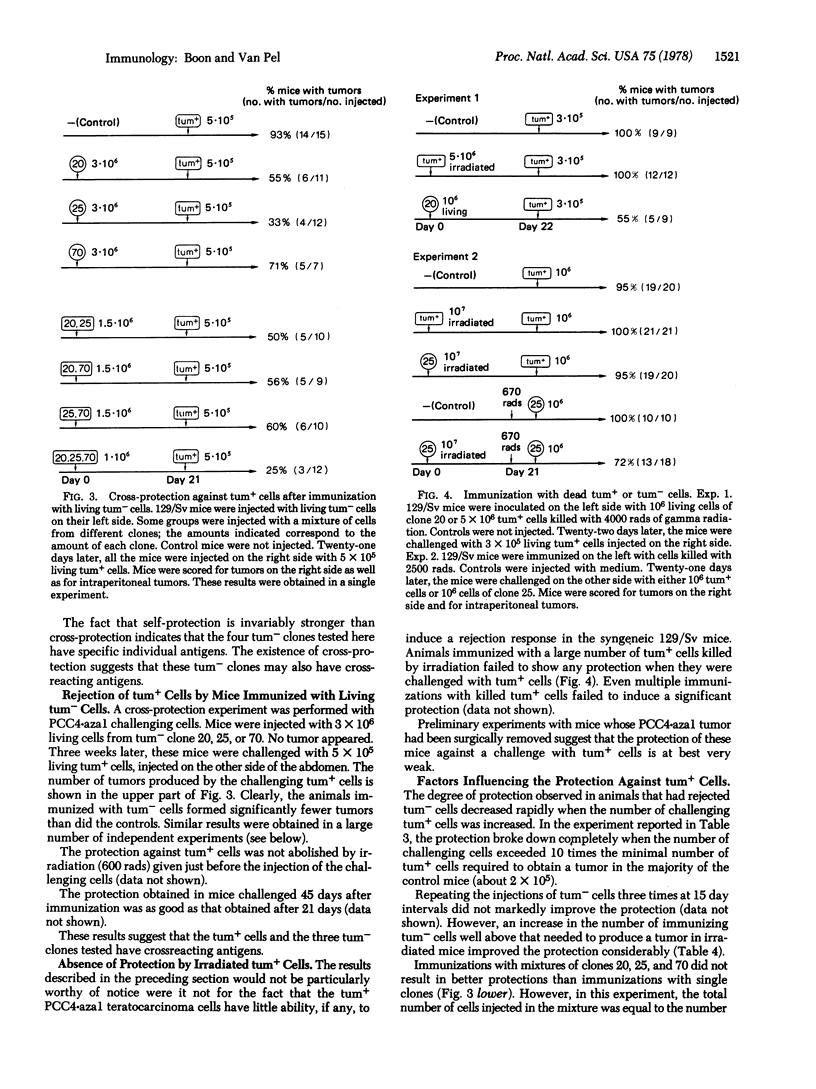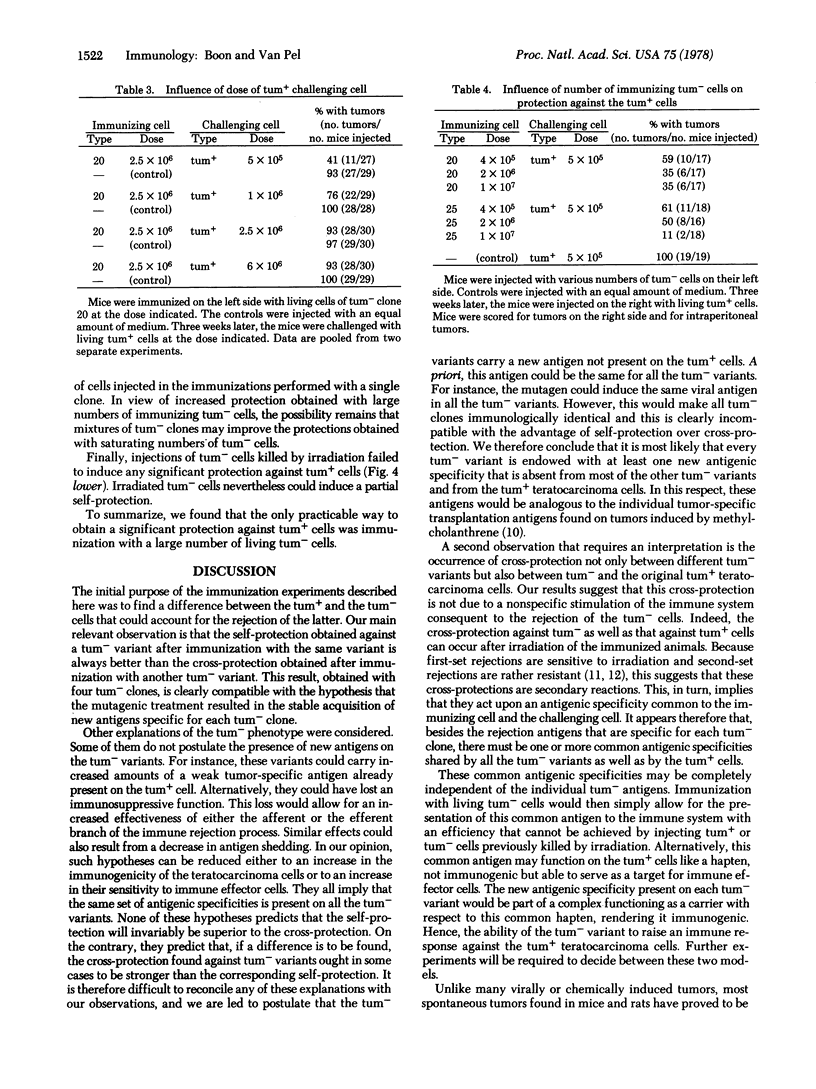Abstract
We reported previously that, by mutagenesis of a malignant teratocarcinoma cell line, it is possible to obtain a number of variant clones that are incapable of forming progressive tumors. Each of these "tum-" variants is rejected in syngeneic mice and stimulates the production of immune memory cells (self-protection). We show here that four different tum- clones confer an immune protection against each other although this cross-protection is invariably weaker than the self-protection. Moreover, mice immunized with living tum- cells are partially protected against the original malignant teratocarcinoma cells, even though the latter cells are incapable of conferring any immune protection when injected after being killed by irradiation. These results indicate that each tum- variant carries at least one specific transplantation antigen that is absent from the original tumor cell line and from most other tum- variants. Other tumor-specific transplantation antigens are probably present on all the tum- variants and also on the malignant teratocarcinoma cell line.
Full text
PDF




Selected References
These references are in PubMed. This may not be the complete list of references from this article.
- Artzt K., Dubois P., Bennett D., Condamine H., Babinet C., Jacob F. Surface antigens common to mouse cleavage embryos and primitive teratocarcinoma cells in culture. Proc Natl Acad Sci U S A. 1973 Oct;70(10):2988–2992. doi: 10.1073/pnas.70.10.2988. [DOI] [PMC free article] [PubMed] [Google Scholar]
- Artzt K., Jacob F. Letter: Absence of serologically detectable H-2 on primitive teratocarcinoma cells in culture. Transplantation. 1974 Jun;17(6):632–634. doi: 10.1097/00007890-197406000-00015. [DOI] [PubMed] [Google Scholar]
- Baldwin R. W. Tumour-specific immunity against spontaneous rat tumours. Int J Cancer. 1966 May 15;1(3):257–264. doi: 10.1002/ijc.2910010305. [DOI] [PubMed] [Google Scholar]
- Boon T., Kellermann O. Rejection by syngeneic mice of cell variants obtained by mutagenesis of a malignant teratocarcinoma cell line. Proc Natl Acad Sci U S A. 1977 Jan;74(1):272–275. doi: 10.1073/pnas.74.1.272. [DOI] [PMC free article] [PubMed] [Google Scholar]
- DEMPSTER W. J., LENNOX B., BOAG J. W. Prolongation of survival of skin homotransplants in the rabbit by irradiation of the host. Br J Exp Pathol. 1950 Oct;31(5):670–679. [PMC free article] [PubMed] [Google Scholar]
- Evans M. J. The isolation and properties of a clonal tissue culture strain of pluripotent mouse teratoma cells. J Embryol Exp Morphol. 1972 Aug;28(1):163–176. [PubMed] [Google Scholar]
- Hewitt H. B., Blake E. R., Walder A. S. A critique of the evidence for active host defence against cancer, based on personal studies of 27 murine tumours of spontaneous origin. Br J Cancer. 1976 Mar;33(3):241–259. doi: 10.1038/bjc.1976.37. [DOI] [PMC free article] [PubMed] [Google Scholar]
- Jakob H., Boon T., Gaillard J., Nicolas J., Jacob F. Tératocarcinome de la spuris: isolement, culture et propriétés de cellules a potentialités multiples. Ann Microbiol (Paris) 1973 Oct;124(3):269–282. [PubMed] [Google Scholar]
- Kahan B. W., Ephrussi B. Developmental potentialities of clonal in vitro cultures of mouse testicular teratoma. J Natl Cancer Inst. 1970 May;44(5):1015–1036. [PubMed] [Google Scholar]
- Klein G., Klein E. Immune surveillance against virus-induced tumors and nonrejectability of spontaneous tumors: contrasting consequences of host versus tumor evolution. Proc Natl Acad Sci U S A. 1977 May;74(5):2121–2125. doi: 10.1073/pnas.74.5.2121. [DOI] [PMC free article] [PubMed] [Google Scholar]
- Lehman J. M., Speers W. C., Swartzendruber D. E., Pierce G. B. Neoplastic differentiation: characteristics of cell lines derived from a murine teratocarcinoma. J Cell Physiol. 1974 Aug;84(1):13–27. doi: 10.1002/jcp.1040840103. [DOI] [PubMed] [Google Scholar]
- MAIN J. M., PREHN R. T. Fate of skin homografts in x-irradiated mice treated with homologous marrow. J Natl Cancer Inst. 1957 Dec;19(6):1053–1064. [PubMed] [Google Scholar]
- Prehn R. T. Tumor progression and homeostasis. Adv Cancer Res. 1976;23:203–236. doi: 10.1016/s0065-230x(08)60547-3. [DOI] [PubMed] [Google Scholar]
- Rosenthal M. D., Wishnow R. M., Sato G. H. In vitro growth and differetiation of clonal populations of multipotential mouse clls derived from a transplantable testicular teratocarcinoma. J Natl Cancer Inst. 1970 May;44(5):1001–1014. [PubMed] [Google Scholar]
- Stevens L. C. The development of transplantable teratocarcinomas from intratesticular grafts of pre- and postimplantation mouse embryos. Dev Biol. 1970 Mar;21(3):364–382. doi: 10.1016/0012-1606(70)90130-2. [DOI] [PubMed] [Google Scholar]
- TYAN M. L., COLE L. J. DIFFERENTIAL RADIOSENSITIVITY OF FIRST AND SECOND-SET RESPONSES TO ALLOGENEIC AND XENOGENEIC SKIN GRAFTS IN SUBLETHALLY IRRADIATED MICE. Transplantation. 1963 Oct;1:546–551. [PubMed] [Google Scholar]


